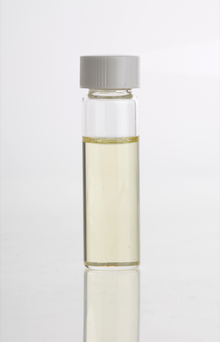Cajeput oil
This article needs additional citations for verification. (September 2012) |

Cajuput oil is a volatile oil obtained by distillation from the leaves of the myrtaceous trees Melaleuca leucadendra, Melaleuca cajuputi, and probably other Melaleuca species. The trees yielding the oil are found throughout Maritime Southeast Asia and over the hotter parts of the Australian continent. The majority of the oil is produced on the Indonesian island of Sulawesi. The name "cajeput" is derived from its Indonesian name, kayu putih or "white wood".[1]
The oil is prepared from leaves collected on a hot dry day, macerated in water, and distilled after fermenting for a night. This oil is extremely pungent, and has the odor of a mixture of turpentine and camphor. It consists mainly of cineol (see terpenes), from which cajuputene, having a hyacinth-like odor, can be obtained by distillation with phosphorus pentoxide. It is a typical volatile oil, and is used internally in doses of 2 to 3 minims, for the same purposes as, say, clove oil[clarification needed]. It is frequently employed externally as a counterirritant.[1] It is an ingredient in some liniments for sore muscles such as Tiger Balm and Indonesian traditional medicine .
It is also used as an ingredient in inhalants/decongestants and topical pain/inflammation remedies such as Olbas Oil.
For fish[]
This section does not cite any sources. (June 2014) |
Cajeput is used for the treatment of bacterial or fungal infections in fish. Common brand names containing Cajeput are Melafix and . Melafix is a stronger concentration and Bettafix is a lower concentration that makes it harder to overdose smaller fish, especially bettas. It is most commonly used to promote fin and tissue regrowth, but is also effective in treating other conditions, such as fin rot or velvet. The remedy is used mostly on betta fish.
See also[]
- Tea tree oil – derived from Melaleuca alternifolia
References[]
- ^ Jump up to: a b One or more of the preceding sentences incorporates text from a publication now in the public domain: Chisholm, Hugh, ed. (1911). "Cajuput Oil". Encyclopædia Britannica. 4 (11th ed.). Cambridge University Press. p. 961.
- Essential oils
- Botany stubs